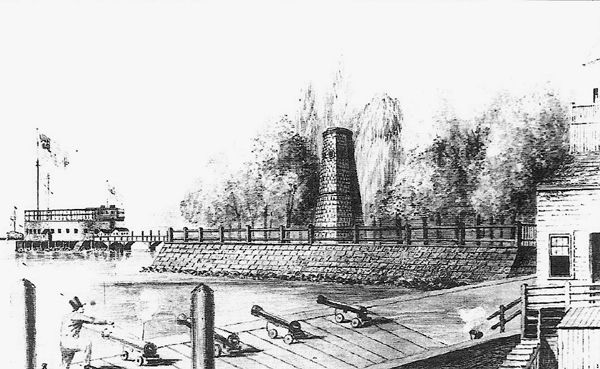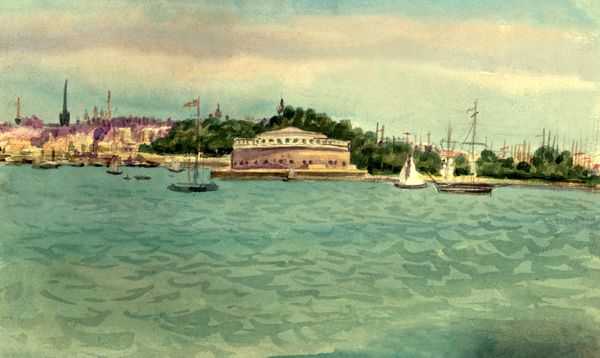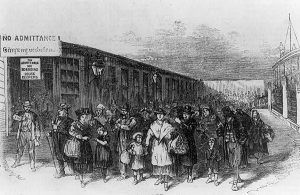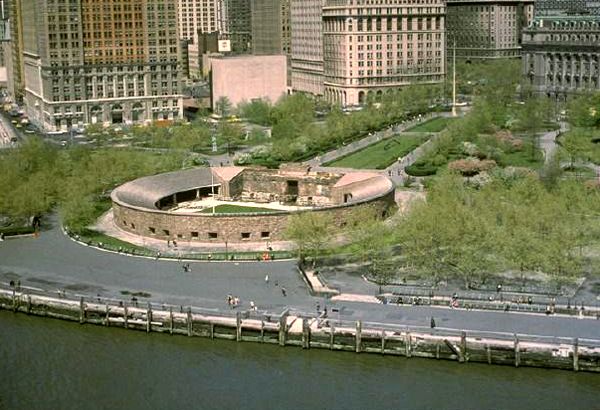Located at the southern tip of Manhattan Island in Battery Park, Castle Clinton stands where New York City began, approximately two blocks west of where Fort Amsterdam stood almost 400 years ago when New York City was known by the Dutch name New Amsterdam.
Also known as Fort Clinton, the circular sandstone fortification was built in anticipation of the War of 1812. Construction began on what was first called the West Battery or Southwest Battery in 1808 and was completed in 1811. Designed by architects John McComb, Jr. and Jonathan Williams, it was built on a small artificial island just offshore. When complete, it was fully armed with 28 cannons, with each having the ability to shoot a 32-pound cannonball a distance of 1.5 miles. Three other fortifications were built at about the same time – Castle Williams on Governor’s Island, Fort Wood on Bedloe’s Island (known today as Liberty Island), and Fort Gibson on Ellis Island.
On March 27, 1812, General Joseph Bloomfield was appointed to the command of all the fortifications in New York City and the harbor. He established his headquarters at Southwest Battery.
Due to long-simmering disputes, the United States declared War on Great Britain on June 18, 1812. The conflict centered on the recognition of American commercial and political rights. Specifically, the reasons included trade restrictions brought about by Britain’s ongoing war with France, the impressment of American merchant sailors into the Royal Navy, British support of American Indian tribes against American expansion, and outrage over insults to national honor after humiliations on the high seas. Two years prior, the British attacked the USS Chesapeake and nearly caused a war. Additional disputes occurred over the Northwest Territories and the border with Canada.
During the Battle of Bladensburg, which occurred on August 24, 1814, the British marched into Washington, D.C., and burned most of the public buildings. President James Madison had to flee into the countryside. The British then turned to attack Baltimore, Maryland, but met stiffer resistance and were forced to retire after the American defense of Fort McHenry, which inspired Francis Scott Key to write the words of the “Star-Spangled Banner.”
The war raged on for several more years until both sides were finally ready to negotiate peace. The Treaty of Ghent was signed on December 24, 1814, but it took several months for the news to arrive back in the United States. The Battle of New Orleans occurred on January 8, 1815, becoming the final major battle of the War of 1812.
The four forts in the New York harbor kept the British Navy at bay, and Southwest Battery never needed to fire upon the enemy. In 1817, the fort was renamed Castle Clinton in honor of DeWitt Clinton, Mayor and, later, Governor of New York.
In 1823, the fort was deeded to New York City. The following summer, a new restaurant and entertainment center opened at the site and was renamed Castle Garden. A roof was added in the 1840s, and Castle Garden served as an opera house and theater. Opera singer Jenny Lind, The Swedish Nightingale, made her American debut here in 1850. She was brought to America by none other than P.T. Barnum. In 1851, European dancing star Lola Montez performed her notorious “tarantula dance” in Castle Garden. In 1853 and 1854, the famous and very eccentric French conductor and composer of light music Louis-Antoine Jullien (1812-1860) gave dozens of very successful concerts mixing classical and light music. The building continued to operate as an entertainment center until 1854.
By 1855, successive landfills had enlarged the Park to encompass Castle Garden. On August 3, 1855, the old fortress became the Castle Garden Immigration Station, the first official immigration processing center in the nation. Representing a country at a crossroads signaled a change in American immigration policy and in the ways through which immigrants became Americans. During the next 34 years, over 8 million people entered the United States through Castle Garden, which amounted to two out of every three immigrants to the United States in this period. The state of New York operated it until April 18, 1890, when the Federal Government took over control of immigration processing and subsequentially opened the larger and more isolated Ellis Island facility on January 2, 1892.
With the Federal government taking control of immigration and the opening of Ellis Island, Castle Garden was transformed into the New York Aquarium, one of the nation’s first public aquariums. After significant remodeling, including a roof of several stories, the New York City Aquarium opened on December 10, 1896. The exotic fish and Beluga whale made the aquarium one of the city’s most popular attractions. With over 30,000 visitors on opening day, the aquarium averaged over 5,000 people per day over the years of its service. The New York City Aquarium was relocated to Coney Island in 1941.
After the aquarium was moved, the structure was nearly demolished to build a crossing from the Battery to Brooklyn. However, the public outcry at losing a popular recreation site and landmark halted the demolition efforts. Afterward, a significant preservation battle took place, and the original fort walls were declared a National Monument by an Act of Congress in 1946. The National Park Service restored the castle to its original design, and the site reopened in 1975 as Castle Clinton National Monument.
Today, the site houses the ticket office for the Statue of Liberty, the Ellis Island ferry, and a small interpretive display of its history. Castle Clinton receives an annual visitation of over three million people, making it one of the most visited National Park Service sites in the country.
Castle Clinton is located in historic Battery Park. It is only directly accessible by foot, bicycle, or wheelchair. You cannot drive directly to the site. Local parking is nearly impossible to find and expensive. All public transportation options are located outside Battery Park.
More Information:
Castle Clinton National Monument
212-344-7220.
Compiled by Kathy Alexander/Legends of America, updated March 2024
Also See:
Discovery and Early Occupation of New York City
History of New York – Empire State
Primary Source: National Park Service




